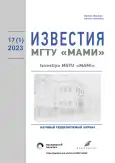Increasing efficiency and safety of operation of underground tunnel escalators. The software architecture
- Authors: Popov V.A.1, Elantsev V.V.1
-
Affiliations:
- Emperor Alexander I St. Petersburg State Transport University
- Issue: Vol 17, No 1 (2023)
- Pages: 63-76
- Section: Electrotechnical facilities and systems
- URL: https://journals.rcsi.science/2074-0530/article/view/131457
- DOI: https://doi.org/10.17816/2074-0530-109890
- ID: 131457
Cite item
Full Text
Abstract
BACKGROUND: An essential condition of existence for enterprises of all forms in the face of rapid external and internal transformations is digital reformation of their business processes. The Saint Petersburg subway is no exception, which has an aging fleet of escalators, for which the introduction of digital technologies, accompanied by the optimization of the control system for the main technological processes, can provide a balance between ever-increasing costs and limited, not always rhythmically flowing supplies.
AIMS: To establish one of the possible options for the software architecture for planning and monitoring maintenance and repair of the subway escalator fleet. At the same time, the object of research in the study is the subway escalator fleet, and the subject is automation of the maintenance and repair system.
METHODS: Analysis of modern architectural solutions used in the design of software (materials), and the synthesis on their basis of a microservice architecture implemented by tools taken from the field of machine learning and artificial intelligence are the methods used in this study.
RESULTS: A significant result of the work for practical application is the proposed scheme of the two-circuit IT landscape of the information system and the block diagram of the software implementing the internal processing circuit. The proposed version of the software is intended for regular use as a tool for monitoring and controlling the register of management objects (works) that create and do not create value for the company (providing/not providing transportation of passenger traffic). At the same time, the implementation of the proposed circuit design solution can be carried out using ready-to-use and free software components, significantly reducing the design time and the cost of its creation and operation.
CONCLUSIONS: The results obtained may be one of the options for implementing the concept of digital transformation of the maintenance and repair system of the subway escalator fleet.
Full Text
##article.viewOnOriginalSite##About the authors
Valery A. Popov
Emperor Alexander I St. Petersburg State Transport University
Email: vpopov_58@mail.ru
ORCID iD: 0000-0003-2635-5427
SPIN-code: 2418-7152
Associate Professor, Dr. Sci. (Tech.), Associate Professor of the Mechanical Handling and Road Building Machines Department
Russian Federation, Saint PetersburgValentin V. Elantsev
Emperor Alexander I St. Petersburg State Transport University
Author for correspondence.
Email: evv3012@gmail.com
ORCID iD: 0000-0003-1731-5626
SPIN-code: 9667-9716
Postgraduate of the Mechanical Handling and Road Building Machines Department
Russian Federation, Saint PetersburgReferences
- Results of the socio-economic development of St. Petersburg for January-May 2022. Iss. 5. [internet]. St. Petersburg: Committee for Economic Policy and Strategic Planning of St. Petersburg; 2022. (in Russ). [cited 2022 Aug 14] Available from: https://cedipt.gov.spb.ru/media/uploads/userfiles/2022/07/04/СПРАВКА_ЧП_янв-май_2022_электронный_вариант.pdf
- Accounting (financial) statements of the metro for the first quarter of 2022: official website [internet]. St. Petersburg: State Unitary Enterprise “Petersburg Metro”; 2022. (in Russ). [cited 2022 Aug 14] Available from: http://www.metro.spb.ru/uploads/document/fin_otch_1kv2022.pdf
- Korneeva AV, Korneev GU. Business processes: from value to profit. Vestnik Altayskoy akademii ekonomiki i prava. 2021;7(2):168–175. (in Russ). doi: 10.17513/vaael.1795
- Varzunov AV, Torosyan EK, Sazhneva LP. Analysis and management of business processes. St. Petersburg: ITMO; 2016. (in Russ). [cited 2022 Aug 14] Available from: https://books.ifmo.ru/file/pdf/2017.pdf
- Pavlov AV. Architecture of computing systems. St. Petersburg: ITMO; 2016. (in Russ). [cited 2022 Aug 14] Available from: https://books.ifmo.ru/file/pdf/2074.pdf
- Khoroshevsky VG. Computing architecture. Tutorial. Moscow: Izd-vo MGTU im. H.E. Baumana; 2008. (in Russ). [cited 2022 Aug 14] Available from: https://nsu.ru/xmlui/bitstream/handle/nsu/935/khor32.pdf
- Dandan R. Methodological materials for the formation of a map of contexts. International Journal of the Humanities and Natural Sciences. 2022;5–2(68):21–25. (in Russ). doi: 10.24412/2500-1000-2022-5-2-21-25
- Sirazetdinov RR, Belous DV. Information systems architecture. Tekhnicheskie sredstva svyazi. 2020;3:65–68. (in Russ).
- Vorobyov AV, Vorobieva GR. Model of information interaction of elements of a multilevel system of digital twins. Informatika i avtomatizatsiya. 2021;20(3):530–561. (in Russ). doi: 10.15622/ia.2021.3.2
- Pletnev AV. Choosing a technology stack for an IT project. Internauka: elektron. nauchn. zhurnal. 2021;36(212). (in Russ). doi: 10.32743/26870142.2021.36.212.303217
- Gorodnichev MG, Polonsky RV. Evaluation of the possibility of using microservice architecture in the development of user interfaces for client-server software. Ekonomika i kachestvo sistem svyazi. 2020;3(17):33–43. (in Russ). [cited 2022 Aug 14] Available from: http://nirit.org/wp-content/uploads/2020/09/33-43.pdf
- Richardson K. Microservices. Patterns of development and refactoring. St. Petersburg: Piter; 2019. (in Russ).
- Popov VA, Elantsev VV. On the issue of improving the efficiency and safety of operation of underground tunnel escalators. The concept of digital transformation of the maintenance and repair system. In: Sistemy avtomatizirovannogo proektirovaniya na transporte: materialy IX Mezhdunarodnoy nauch.-prakt. konf. studentov, aspirantov i molodykh uchenykh (St. Petersburg, April 27–28, 2021). St. Petersburg: Izd-vo FGBOU VO PGUPS; 2021:91–96. (in Russ).
- Shinkarev AA. Retrospective of the development of web technologies in the creation of corporate information systems. Vestnik Yuzhno-Uralskogo gosudarstvennogo universiteta. Seriya: Kompyuternye tekhnologii, upravlenie, radioelektronika. 2020;20(4):14–21. (in Russ). doi: 10.14529/ctcr200402
- Simankov VS, Sharay VA. Software and hardware of the subsystems of the intelligent situational center. Vestnik Adygeyskogo gosudarstvennogo universiteta. Seriya 4: Estestvenno-matematicheskie i tekhnicheskie nauki. 2021;3(286):63–72. (in Russ). doi: 10.53598/2410-3225-2021-3-286-42-54
- Decree of the Government of the Russian Federation No. 80-r dated January 25, 2018 “On the development of project activities in the Government of Russia” (with amendments and additions). (in Russ). [cited 2022 Aug 14] Available from: http://government.ru/docs/31211/
- Methodological recommendations of the Government of the Russian Federation “Guidelines for the organization of project activities in federal executive bodies” No. 1937p-P6 dated March 12, 2018 (as amended). (in Russ). [cited 2022 Aug 14] Available from: http://government.ru/info/31672/ Дата обращения: 13.08.2022.
- Methodological guide “Functioning of project offices” (with changes and additions) [internet] Moscow: Tsentr proektnogo menedzhmenta; 2022. (in Russ). [cited 2022 Aug 14] Available from: https://pm.center/bazaznaniy/document/metodicheskoe-posobie-funktsionirovanie-proektnykh-ofisov/
Supplementary files












